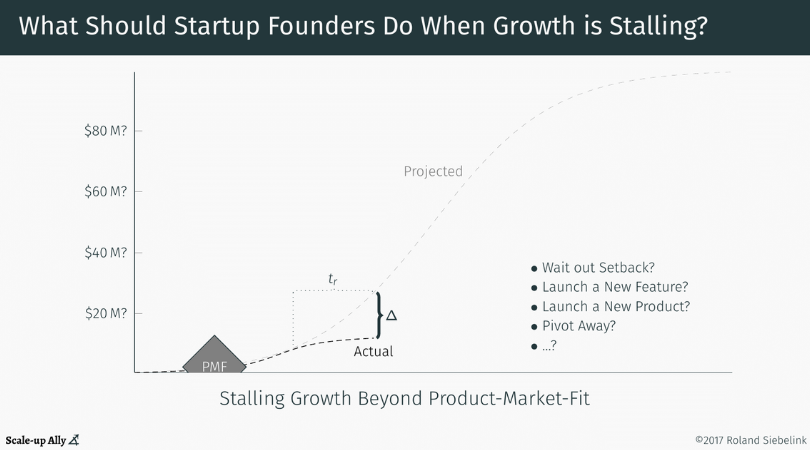What to Do When Startup Growth Stalls?

Sustaining growth is crucial
Startup life does not get easier after Product-Market-Fit. To reach product-market-domination before competitors, your startup has to maintain ever increasing growth. Until far into the market majority.
Stalling growth may not be such a problem if you rely on internal funds. But if you need venture capital, stalling growth is a death knell. On a tricycle you can stop and sit still, but on a bicycle you need to keep moving not to fall over.
Have you raised venture capital? You have no doubt told investors about amazing growth potential in a massive market. As soon as your growth rate slow down, investors worry about losing that potential. It will not be long before they suggest new management might do a better job than the founders.
Growth is not Automatic
But sustained growth is not automatic. Founding myths often suggest growth exploded as soon as the company reached Product-Market-Fit.
But in reality, most startups experience a premature flattening of their growth curve. Often more than once in their journey.
Not only is it possible to overcome a growth stall. It is also necessary that founders prepare to deal with one.
Response time too slow
For most founders I work with, the first challenge is to shorten the time it takes to respond to a growth stall. See t(r) in the chart.
It is obvious that, the longer the startup takes to respond to the growth stall, the bigger the gap they must bridge. So why is founders’ response time so long?
Undiluted Kool-Aid
The problem is the Kool Aid factor. In the early startup stage, it is crucial to assemble a team of “true believers”. Following the Founder’s vision and drinking the Kool-Aid is the mark of a loyal cofounder.
When the startup finally reaches Product-Market-Fit, the vision is completely vindicated. New funds flow in and the team doubles down on Kool-Aid expectations. Soon, the organization develops cognitive dissonance and blind spots occur.
A growth stall indicates that the vision needs adjusting. It requires admitting you have a problem that Kool-Aid alone will not solve. Only founders who work hard to create a culture of debate and dissonance avoid this fate. That is why it is crucial, in the scaleup stage, to mix one part Kool-Aid with one part reality.
Waiting out the Setback?
Teams with undiluted Kool-Aid often fail to respond to the growth stall altogether. Even after the numbers have become obvious and investors get worried.
Management teams tend to explain away disappointing numbers as temporary setbacks. Waiting out the setback seems easier than making changes.
Launching a New Feature?
Tech companies, in particular, often blame the growth stall on a missing feature:
-
An important prospect has been asking for something the product does not support.
-
A key competitor already offers a feature that is still on our roadmap.
-
But most often, the founder imagines that a key feature from the product vision will spark new growth.
Launching a New Product or Pivoting?
Some teams interpret a growth stall as a failure in Product-Market-Fit:
-
We declared Product-Market-Fit too early.
-
The market that the product fits in is far smaller than we projected to investors.
-
Or the product we have serves a less attractive side of the (much larger potential) market.
In these situations, teams often focus on building or buying a new product. Sometimes they even step back to Lean Startup frameworks to pivot away. With the hope of finding new Product-Market-Fit.
Jumping to a Solution
So what is the right solution to dealing with a growth stall? It starts with finding out what is the root cause of the stalling growth…